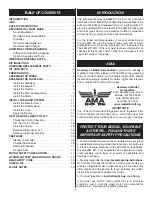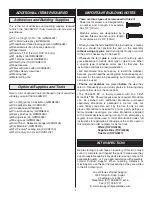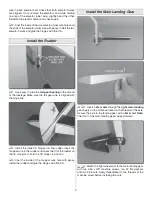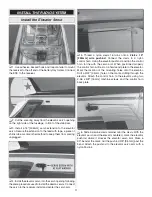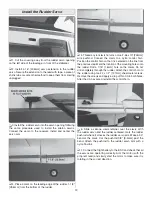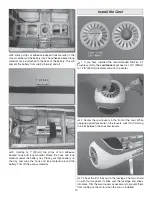
14
Apply the Decals
The box photographs show the location of the decals on
the airplane. Refer to the box for the exact placement of the
decals. The following tips may be useful for applying them.
❏
1. Remove the decals from the decal sheet.
❏
2. Be certain the model is clean and free from oily
fingerprints and dust. Prepare a dishpan or small bucket with
a mixture of liquid dish soap and warm water—about one
teaspoon of soap per gallon of water. Submerse the decal
in the soap and water and peel off the paper backing.
Note:
Even though the decals have a “sticky-back” and are not the
water transfer type, submersing them in soap & water allows
accurate positioning and reduces air bubbles underneath.
❏
3. Position decals on the model. Holding the decals down,
use a paper towel to wipe most of the water away.
❏
4. Use a piece of soft balsa or something similar to
squeegee remaining water from under the decal. Apply the
rest of the decals the same way
GET THE MODEL READY TO FLY
Check the Control Directions
❏
1. Turn on the transmitter and receiver and center the
trims. If necessary, remove the servo arms from the servos
and reposition them so they are centered. Reinstall the
screws that hold on the servo arms.
❏
2. With the transmitter and receiver still on, check all the
control surfaces to see if they are centered. If necessary, adjust
the clevises on the pushrods to center the control surfaces.
FULL
THROTTLE
RUDDER
MOVES
RIGHT
ELEVATOR
MOVES DOWN
RIGHT AILERON
MOVES UP
LEFT AILERON
MOVES DOWN
4-CHANNEL RADIO SET UP
(STANDARD MODE 2)
❏
3. Make certain that the control surfaces and the throttle
respond in the correct direction as shown in the diagram.
If any of the controls respond in the wrong direction, use
the servo reversing in the transmitter to reverse the servos
connected to those controls. Be certain the control surfaces
have remained centered. Adjust if necessary.
Set the Control Throws
To ensure a successful first flight, set up your Yak-55M EP
according to the control throws specified in the manual.
The throws have been determined through actual flight
testing and accurate record keeping, allowing the model
to perform in the manner in which it was intended. If, after
you have become accustomed to the way the Yak-55M
flies, you would like to change the throws to suit your flying
style, that is fine. However, too much control throw could
make the model too responsive and difficult to control, so
remember, “more is not always better.”
❏
1. Use a box or something similar to prop up the bottom of
the fuselage so the horizontal stabilizer and wing will set level.
❏
2. Measure the 3D elevator throw first. Hold a ruler
vertically on your workbench against the widest part
(front to back) of the trailing edge of the elevator. Note the
measurement on the ruler.
These are the recommended control surface throws:
ELEVATOR
LOW RATE
RUDDER
AILERONS
5/16"
[8mm]
5°
Up
5/16"
[8mm]
5°
Down
1-3/4"
[44mm]
20°
Right
1-3/4"
[44mm]
20°
Left
1/2"
[13mm]
8°
Up
1/2"
[13mm]
8°
Down
3D RATE
1-7/8"
[48mm]
34°
Up
1-7/8"
[48mm]
34°
Down
2-1/2"
[64mm]
29°
Right
2-1/2"
[64mm]
29°
Left
1-3/4"
[44mm]
28°
Up
1-3/4"
[44mm]
28°
Down
HIGH RATE
5/8"
[16mm]
11°
Up
5/8"
[16mm]
11°
Down
2-1/8"
[54mm]
25°
Right
2-1/8"
[54mm]
25°
Left
3/4"
[19mm]
12°
Up
3/4"
[19mm]
12°
Down
Summary of Contents for YAK-55M Yakovlev
Page 20: ......


